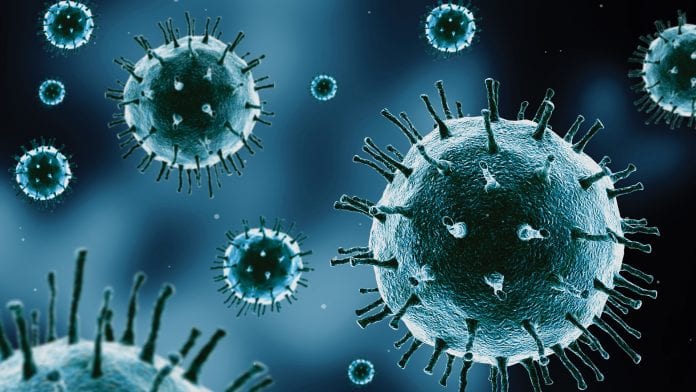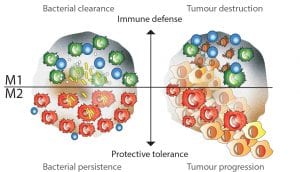
Dr Maija Hollmén at the University of Turku highlights the possibility of re-purposing macrophage stimulating cancer drugs to treat persistent bacterial infections.
Some bacterial infections are able to evade the host immune system and persist for years or even decades, potentially increasing morbidity and mortality from the infection itself as well as increasing risk of malignancy and dissemination of the disease. Eradication of persistent infections is complex, often needing prolonged or repeated courses of antibiotics.
A key element of the persistence of bacterial infection is the ability of bacteria to modulate immune responses in the infected host, which leads to impaired pathogen clearance accompanied by dampened immune responses under which bacteria remain undetected.
Macrophages engulfing these pathogens are central to many such infections since they provide a protected niche in which bacteria remain viable, for example during antibiotic pressure. The persistent bacterial populations are able to re-programme macrophage responses from an immunostimulatory to an anti-inflammatory phenotype to provide a growth advantage to the bacteria.1
Intriguingly, a similar phenotypic switch in macrophages occurs during tumour immune evasion, suggesting the possibility of re-purposing macrophage targeted immune activating cancer drugs for treating persistent infections such as M. tuberculosis and Salmonella Typhi.
Macrophage responses in tuberculosis
Tuberculosis (TB) has infected about 1.7 billion people worldwide and accounts for nearly three million deaths every year. TB is transmitted via the respiratory route and infects resident alveolar macrophages and dendritic cells.2 The host immune system arrests infection by forming a structure called granuloma that stamps down the imminent threat of active infection by limiting bacillary dissemination (Fig. 1). Bacillary control in the granuloma tissue depends on local production of Th1 cytokines by antigen-specific T lymphocytes, leading to sustained phagocyte activation, inflammation and antimicrobial activity.
If the granuloma response is impaired the bacilli continue to replicate, promoting active TB that leads to the development of cavitary pulmonary disease. On the other hand, granuloma conditions like hypoxia, nutrient starvation and free radicals induce a metabolic shift in the mycobacteria cells to a non-proliferative state, allowing them to survive for long periods inside the infected cells forming a disease state called latent tuberculosis.
The persistence of the bacilli in granulomas is additionally supported by the unique regulatory nature of alveolar macrophages and recruited bystander innate myeloid cells that promote immunosuppression by secreting prostaglandin E2, transforming growth factor-ß and interleukin-10 to protect the delicate lung tissue from inflammatory damage.
Roughly one-third of the world population is infected with this latent form of TB. These individuals carry a lifetime risk of developing clinically significant disease at a later time.
This risk is significantly increased by immunosuppressive triggers, including HIV infection, tumour necrosis factor (TNF) neutralisation therapy for other diseases, as well as diabetes.
TB carriers having the highest risk of developing active disease are generally treated 6-9 months with isoniazid, rifampicin or isoniazid together with rifapentine. These treatments have a protective effect against active TB but are also related to hepatotoxicity and low compliance. Moreover, the evolution of M. tuberculosis strains that are resistant to these drugs form a significant challenge in treating TB. Therefore, it is necessary to develop effective drugs with fewer side effects against latent tubercular bacilli.

Macrophage responses in tumours
Genetic alterations in normal cells can create neoplastic changes that lead to uncontrolled growth and spread of malignant cells. Our immune system, however, is capable of recognising and eliminating such cells by a tightly regulated process involving cells of the innate and adaptive immune system. Once attacked by the immune system the cancer cells adopt to the stress by editing several signalling pathways that help them survive.
This includes the promotion of an immunosuppressive tumour microenvironment where innate immune cells, such as macrophages, are educated from an anti-tumoral (M1) phenotype towards a pro-tumoral (M2) phenotype (Fig. 1). This ultimately leads to impaired function of cytotoxic T-cells and immune escape of the fittest cancer cells. A highly potential approach to improve elimination of cancer cells by the immune system is to re-programme macrophages from M2 to M1 in the tumour microenvironment.
Various stimulating agents, such as agonistic anti-CD40 or inhibitory anti-CD47 antibodies, as well as Toll-like receptor ligands, are under clinical development in order to activate immune-based tumour recognition and pro-inflammatory responses of myeloid cells.
Additionally, reprogramming of macrophages by a selective class IIa histone deacetylase (HDAC) inhibitor or with a PI3Kγ inhibitor has been shown to have potential benefits in improving current immunotherapy in mouse models.
Clever-1 – the dark horse
In recent years, increasing attention has been paid to the contribution of scavenger receptors in regulating macrophage responses to different stimuli. Scavenger receptors form a vital part of host defence and homeostasis by removing extraneous or modified self-macromolecules and acting as co-receptors in the priming of the effector immune responses when danger signals are detected. Clever-1 (also known as Stabilin-1) is a multifunctional molecule conferring scavenging ability on a subset of anti-inflammatory macrophages.
In these cells, it is involved in receptor-mediated endocytosis and recycling, intracellular sorting, and transcytosis of altered and normal self-components. Clever-1 is upregulated in situations where immunosuppression is needed to sustain homeostasis of the body. Both cancer and invading pathogens can hijack this delicate system of immunological balance and skew it in their favour. This can be seen as an increase in Clever-1 positive macrophages for example in the tumour microenvironment, which promotes tumour progression in many types of human cancers.
Clever-1 inhibits macrophage pro-inflammatory cytokine secretion and antigen presentation, thereby suppressing CD8 T-cell mediated anti-tumour immunity. These observations have led to the clinical development of a Clever-1 targeting antibody (CLEVEGEN, Faron Pharmaceuticals Ltd) to induce macrophage mediated immunostimulation in various cancers.
Notably, Clever-1 has been identified to interact with mycobactin synthase protein B (3), a protein belonging to the mycobactin synthase complex that produces iron chelating siderophores in mycobacteria. Since iron is an essential nutrient for microorganisms but is strongly bound to host proteins in mammals, siderophores are used by mycobacteria to transport iron across cell membranes. Restricting iron availability is an important strategy to defend against bacterial infections.
Therefore, in addition to its importance in mediating immunosuppressive activities in macrophages Clever-1 could have a fundamental role in regulating intracellular M. tuberculosis survival via iron uptake.
References
- Staples DAC, Hill PWS, Westermann AJ, Fisher RA, Thurston TI, Saliba A-E, Blommestein I, Vogl J, Helaine S. Salmonella persisters undermine host immune defense during antibiotic treatment. Science 2018; 362:1156-1160
- Guirado E, Schlesinger LS, Kaplan G. Macrophages in tuberculosis: friend or foe. Semin Immunopathol 2013;35:563-83
- Rapanoel HA, Mazandu GK, Mulder NJ. Predicting and analyzing interactions between Mycobacterium tuberculosis and its human host. PLoS One 2013;8:e67472
Maija Hollmén, PhD, Doc.
Academy Research Fellow
MediCity Research Laboratory
Institute of Biomedicine
University of Turku
+358 50 514 2893
Tweet @maijahollmen @HollmenMaija
maija.hollmen@utu.fi
www.hollmenlab.com
Please note, this article will appear in issue 8 of Health Europa Quarterly, which will be published in February 2019.









